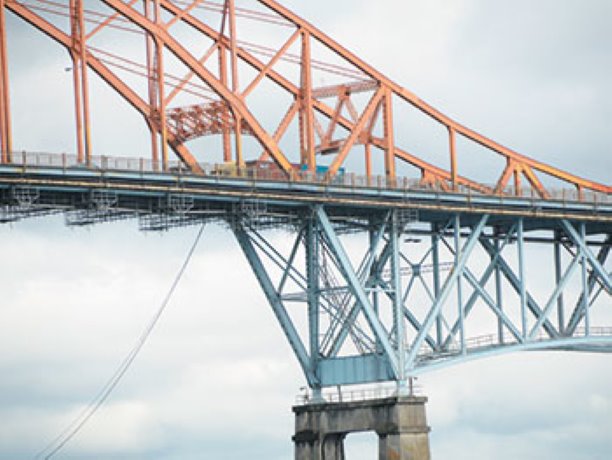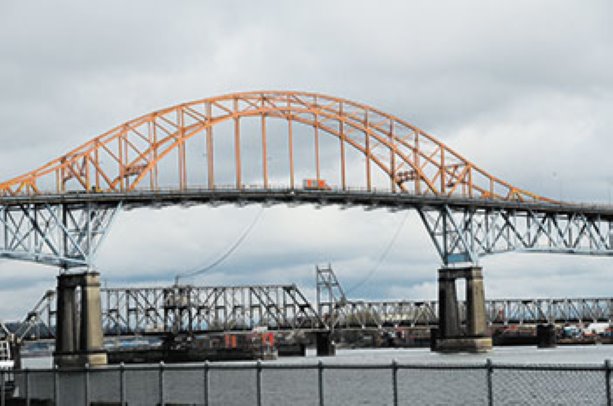The venerable Pattullo Bridge marks its 77th birthday this year and recent reports in Lower Mainland media suggest the old fellow is not in good shape.
“The Pattullo Bridge was opened in 1937,” said Sany Zein, director of infrastructure and network management for TransLink, which owns and operates the bridge.
“It’s showing its age and has a few challenges.”
Multiple recent reports indicate that the concrete in the bridge’s sidewalk is crumbling away from the support beams of the guardrails in many places.
Although there is scaffolding below the bridge, crumbling concrete can fall from the side of the bridge and hit vehicles or rail cars below.
Some of the welds holding the horizontal guard rail to the vertical support beams are crumbling, rusted or missing.
Zein said the Pattullo was designed according to 1930s standards and much has changed in bridge construction techniques since then.
“Its lanes are narrow, there are no shoulders and the sidewalks are sub-standard,” he said.
“And, it wasn’t designed to modern seismic standards. The bridge would be challenged by a moderate seismic event.”
One of the reasons for the bridge’s aches and pains is a recent increase in traffic, which rose by five to six per cent after the first tolls were introduced on the new Port Mann Bridge in December 2012.
Traffic went up another five per cent after the second toll increase came into effect in January 2014.
Base tolls are now $3 for small vehicles, $6 for medium vehicles and $9 for large vehicles.
“But, tolls aren’t the only possible reason for the increased traffic on the Pattullo,” Zein noted.
“Other variables, including economic and population growth in the region, need to be considered too.”
Zein said TransLink has been monitoring the condition of the steel and concrete on the bridge, as well as the number and depth of potholes.
TransLink has an annual repairs budget for the bridge of about $3 million.
The future of the Pattullo Bridge is unclear.
“It is possible that it might be rehabilitated, which would involve upgrading the bridge’s seismic resiliency and replacing the deck,” Zein said.
“The project would cost about $299 million.”
The rehabilitation project is in the design stage, and would be undertaken in 2015, 2016 and 2017.
The project, however, might be scaled back if TransLink and the municipalities of New Westminster, Surrey and Coquitlam agree to go ahead with the construction of a new bridge to replace the Pattullo.
What actually happens will be determined not only by engineering considerations, but also by politics.
In February 2014, The Ministry of Transportation said it was willing to fund one-third of the cost of replacing the Pattullo.
The catch is that the cities need to come to an agreement to replace the bridge, instead of rehabilitating it, and it is uncertain if there will be a meeting of the minds.
David Harvey, senior structural specialist at Associated Engineering, said the Pattullo was one of the first bridges across the Fraser River.
“It has an arched main span, with steel truss approach spans,” he said.
“It was a common bridge construction technique in the 1930s.”
Harvey said much of what makes up contemporary bridge engineering was unknown 75 years ago.
“Materials are generally stronger and more durable,” he said.
“Components and fabrications are superior and more sophisticated. Construction equipment is more effective. For example, we can install larger and stronger piles to support the foundations.”
Modern bridge engineering can also produce much better designs, which are well suited to the anticipated loads.
“For example, (there can be) improved resistance to ship impact, river scour and earthquakes,” Harvey said.
He added that a replacement for the Pattullo Bridge would most likely be a cable-stayed structure, not unlike the adjacent Skybridge, which is the longest cable-stayed transit-only bridge in the world.
“Skybridge has a high percentage of concrete,” he said.
“The only steel is in the cables. But, it’s impossible to say how much concrete a replacement for the Pattullo might have.”
Dr. Nemkumar Banthia, a specialist in materials engineering in the University of British Columbia’s civil engineering department, said the concrete used in structures built in the 1930s cracks more easily, which lets in chlorides that corrode the steel reinforcements in concrete.
“Contemporary high-performance concrete, in contrast, has a different composition that is more resistant to cracking and is denser, which keeps out corrosion-causing chlorides,” he said.
More Concrete:
- VIDEO: Brian Hubbs of RDH Building Engineering on insulating concrete forms
- Carbon tax may give unfair advantage to foreign cement
- Building green with the help of concrete
- Concrete toboggans take the plunge
- Arctic concrete pour defies subzero work conditions
- Concrete industry unites to spread sustainability message
- Insulating concrete forms hailed as efficient solution
- Concrete eating robot could render rubble recyclable
- Reports delve into concrete’s role in infrastructure renewal
- Lafarge, Holcim in talks to merge the world’s two largest cement companies




Recent Comments
comments for this post are closed